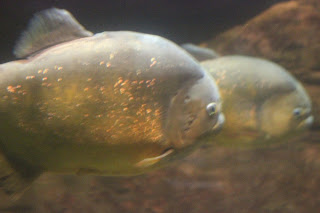1. The relationship between clown fish and sea anemones is that clown fish have a special coating on them that is the same as on the sea anemones, so when the clown fish swim through the anemones, it thinks it's just one of it's tentacles and doesn't try to eat it.
2. Sea otters must maintain their coats in order to stay warm in the cold waters they live in, because they do not have any blubber to do the job.
3. Before the 1900's, the western coast (from Alaska to California) were the only places you could find sea otters. Because they were being hunted so much, an effort to repopulate the western coast was put to the test and 89 otters from Alaska were brought to Vancouver Island in 1969. Without sea otters our western coastline would not have any fish or kelp.
4. The colour of the sea anemones next to the sea otters tank are bright neon green with a dark green body.
6. At the Vancouver Aquarium, there are two beluga whales. The beluga whale, is also known as "Delphinapterus" because it means fin-less whale, as seen in the picture.
7. Sea horses are very small creatures that like to tied down to plants on the bottom of the sea floor. They don't often move but if they have to it's very slow and careful movement, keeping an eye out for prey
8. "The head of the jelly fish can represent the head, which is where the main part of the nervous system is, and the tentacles can represent the countless nerves that go throughout our body."
9. The two most important abilities for a starry flounder to survive is being able to camouflage with the ground area around it, as well as it's ability to play dead in a close encounter with a predator.
10. Moon- Jellies use their head for movement, they slowly let themselves float down and then their head goes in a somewhat flattened position and pushes out all the water from under it, "shooting" it in the direction it is wanting to go. While bringing in water, little planktons are sucked up and eaten through the mouth.
11. The purpose of the white suction cups on octopi are to be able to climb plants and rocks as well as grab and kill prey in their grasp. They are known as natures best predator because they are able to camouflage into any colour as well as change their skin texture to match what they are hiding on, in order to catch their prey without realization.
12. The feeding types of sea lions are changing vigorously, but they are mainly pack feeders who work together in groups to attack prey. They will eat anything from squid - octopi, to herring and pollock.
13. Originated from Bolivia, Argentina, Brazil, and Paraguay
14. The colour of the crocodile is good for camouflage as they mostly live in swampy water and in areas where there is lots of trees and plants, making it an easy attack on prey.
15. The largest fish in the Aquarium was the Arapaima
16. A vegetarian fish, also known as Redhook Silver Dollar eats seeds off of shrubs from riversides.
17. When being removed from their hooks while being fished, they become the biggest threat to humans because they are still alive and very capable of biting.
18. Sharks do not have any bone, but in fact are made up of cartilage.
19. In the tank with the sharks there were also stingrays, different types of fish, and one large sea turtle
20. Sea urchins use their spiky bodies to protect themselves, making them a very painful meal.
21. Archerfish gather water into their mouths and then shoot them at insects above water, knocking them into the water for the fish to eat.
22. The turtle at the aquarium is called "Schoona"
Excitement filled the air that morning as about 50-60 kids piled into one school bus, along with two teachers as supervision, to be driven out to the Vancouver Aquarium. It was a long day but it was well worth it, having to only wait a short while out in the cold to get inside. As soon as you enter the first things you see are round tanks filled with tiny colourful fish in the middle of the hall, to the sides you could see sea anemones and jelly fish and on the other side a huge snake! Immediately Shaineel pulled out his camera and started taking some great shots of the fascinating creatures, and from there we started going through our list finding all the pictures we needed for our scavenger hunt. We had about two hours before it was lunch, which was plenty of time to go around in circles trying to find what we needed. After having a quick bite to eat we hung out with some friends and then proceeded to our "wet lab" that took up the rest of our time there. I think that was my favourite part of the whole trip- being able to handle starfish and sea urchins, touching sea cucumbers and crabs, as well as poking around at the sea anemones. It was easily my favourite field trip so far for biology and a great and fun learning opportunity.

























